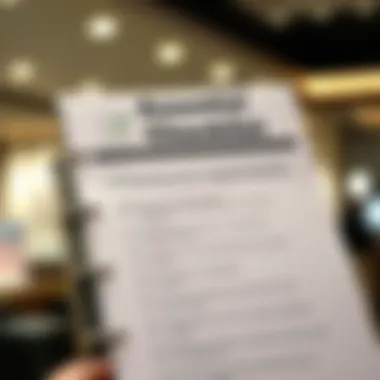Opening a Bank Account at Sixteen: A Complete Guide


Intro
Opening a bank account at the age of sixteen can mark a pivotal moment in a young person’s life. It's not just about having a place to stash your cash; it is about taking the first steps toward financial independence and learning how to manage money responsibly. This guide is designed to help teenagers navigate the process of opening a bank account. By breaking down the requirements, procedures, and considerations involved, we aim to empower young individuals to dive confidently into the banking world.
As adolescents transition into adulthood, they begin to encounter financial responsibilities, from managing a part-time job paycheck to saving for future endeavors. Understanding how to open and operate a bank account is essential for this journey. Not only does it provide a safer alternative to keeping cash at home, but it also opens up avenues for learning about budgeting and financial management.
Key Topics to Explore
We will discuss various elements crucial for opening a bank account. Here’s what you can expect:
- Requirements for opening an account at sixteen, including necessary documentation.
- An overview of different types of accounts available, helping you choose what suits your needs.
- The important role of parental consent, which is often a necessary step in this process.
- Tips and guidelines for making informed banking choices.
This guide aims to equip you with the knowledge to handle your financial future responsibly, turning the daunting task of opening a bank account into an achievable goal.
Understanding the Importance of Banking
Banking serves as the backbone of personal finance, holding significant implications for individuals, especially teenagers stepping into the world of financial independence. As one navigates the myriad of financial responsibilities, understanding banking principles becomes crucial. This section illuminates the essential aspects of why comprehending banking matters, particularly for those just starting their journey.
The Role of Banking in Personal Finance
The role of banking goes beyond just having a place to stash cash. It encompasses managing money effectively, facilitating transactions, and building a financial future. For teenagers who are starting to earn money from part-time jobs or allowances, opening a bank account helps establish the foundation of personal finance management. Reports from financial experts suggest that individuals who start banking early are more likely to develop healthy spending and saving habits.
Having a bank account means access to a range of services that help track income and expenses. Rather than relying on cash, banking enables teens to record and plan their finances better.
"Money management is a skill that can significantly impact one’s future. A bank account is a crucial tool in mastering this skill."
With tools such as online banking, it becomes easier to monitor spending and set budgets. Through digital platforms, young individuals can check balances, view transaction history, and even receive alerts for certain account activities, allowing for better financial awareness and responsibility.
Benefits of Opening a Bank Account Early
Opening a bank account at a young age comes with a myriad of advantages. Here are some notable benefits:
- Financial Literacy: Early exposure to banking fosters an understanding that’s vital for financial independence. Teens learn about interest rates, fees, and budgeting concepts, which are foundational to managing money.
- Savings Culture: Having a dedicated place to save encourages positive habits. A savings account rewards users with interest, making money work harder over time.
- Security: Keeping money in a bank is far safer than storing cash at home. Banks have security measures in place to protect deposits, reducing risks of theft or loss.
- Establishing a Financial Identity: By opening an account, a teen starts to build their own financial history. This can be valuable when applying for loans or credit in the future.
- Convenience: Banks provide various services such as automatic bill payments, which simplify financial tasks. This eases the burden of keeping track of various payment deadlines, letting users manage their finances more efficiently.
Eligibility Criteria for Minors
Understanding the eligibility criteria for minors when it comes to opening a bank account is a crucial part of this guide. This section lays a foundation for how young individuals can navigate their first steps into the world of personal finance. Knowing these criteria not only streamlines the process but also builds confidence in young account holders as they embark on their financial journeys.
Age Requirements
To open a bank account as a minor, the primary requirement is age. Most banks allow teens to establish an account when they reach the age of sixteen. This is significant because it indicates the bank's recognition of a young person's need to manage their finances.
However, there are exceptions. Some financial institutions may permit younger individuals, even those as young as thirteen, to open accounts provided they are accompanied by a parent or guardian. The definitions of a minor can vary from state to state, so it’s wise to check specific local regulations.
Identification Needed
Identification is another critical piece of the puzzle. Banks typically require certain documents to verify the identity of a minor. This process helps in preventing fraud and ensures that the account is legitimate. Generally, the following forms of identification may be required:
- A government-issued photo ID, such as a driver’s license or passport
- A school ID card, especially if accompanied by a parent or guardian
- Birth certificate to show age and relation to the guardian, if applicable
Depending on the bank, there might be additional requirements, so it's best to call ahead and confirm what’s needed.
Parental Consent
Parental consent serves as a safety net for minors opening bank accounts. Most banks require a parent or legal guardian to co-sign the account. This not only fulfills the legal requirement but also allows for guidance as teens learn to manage their finances. Parents have the ability to monitor the account, ensuring that it is used wisely and responsibly.
This relationship can serve as an educational platform where parents discuss budgeting techniques, saving strategies, and the importance of responsible spending. Moreover, the co-signing parent maintains access to the account until the minor reaches adulthood, allowing for proper supervision during the formative years of financial literacy.
"Establishing a bank account at a young age is like planting a tree. It requires the right conditions and nurturing to grow strong and bear fruit in the future."
Types of Bank Accounts Suitable for Teens
Opening a bank account can pave the way for young individuals to develop financial habits that will serve them for a lifetime. Understanding the different types of accounts available is crucial. Each type offers unique benefits that align with the needs and lifestyle of a teenager. In this section, we will explore three primary types of accounts that are suitable for teens: checking accounts, savings accounts, and joint accounts with parents. Knowing these options can help you make informed choices that promote financial responsibility and independence.
Checking Accounts
A checking account is often the first type of account that comes to mind when teenagers think of banking. This account is primarily used for everyday transactions, such as purchasing items or withdrawing cash. It typically comes with features like a debit card, online banking, and the ability to write checks.
For teens, one of the most appealing aspects of checking accounts is the accessibility of funds. You can easily deposit your allowance or earnings from a part-time job and access your money anytime you need it. Learning how to use a checking account is fundamental for managing daily expenses, paving the way for financial literacy.
Also, there's often little to no monthly fee associated with these accounts, especially for minors, making them a cost-effective option. However, it's essential to be mindful of potential overdraft fees. When using this account, setting a budget can go a long way in avoiding unnecessary charges.
Moreover, some banks offer incentives for meeting certain requirements, like making a specific number of transactions per month or maintaining a minimum balance.
Savings Accounts
Savings accounts are designed to help individuals set aside money for future needs. While you may not have immediate access to your funds like you do with a checking account, this account usually offers a higher interest rate, allowing your savings to grow over time.
As a teenager, having a savings account serves as a stepping stone toward understanding the importance of saving. It encourages you to reserve funds for future goals—be it a college fund, a new gadget, or even a car. Many banks require little to no minimum deposit to open a savings account, making it an attainable goal for teens.
In addition, regularly depositing a portion of your allowance or earnings can instill valuable habits, helping you see the rewards of saving.
Joint Accounts with Parents
A joint account can be a smart choice for teenagers just starting their banking journey. This type of account is shared between a teen and a parent or guardian, which allows for financial learning under the guidance of an adult. It’s a way for parents to teach their teens about managing money while maintaining oversight.
One of the key advantages of a joint account is that parents can help track spending and instill budgeting methods, offering insights where necessary. This shared responsibility can encourage discussions around financial goals and values.
However, it’s beneficial for teens to gradually take more responsibility for their finances. Discussions on how to manage the account effectively can lead to valuable lessons in responsibility and accountability. Thus, transitioning to individual accounts becomes a natural progression as they mature.
Researching Banking Institutions
When it comes to opening a bank account at sixteen, it’s not just about the act of opening the account; it’s about choosing the right banking institution that aligns with your financial goals. The right bank can significantly impact your experience, providing you with the tools needed to manage your finances effectively and build good habits early on.
Factors to Consider When Choosing a Bank


Choosing a bank should be a thoughtful process. Here are some factors to consider:
- Type of Account Offered: Look for banks that offer accounts tailored for teenagers or students, as these often come with fewer fees and good terms.
- Fees: Understand any fees associated with the accounts. Some banks offer free accounts, while others may charge monthly maintenance fees which can eat into your savings.
- Interest Rates: Evaluate the interest rates being offered on savings accounts. Not all banks provide competitive rates, and even a small difference can accumulate over time.
Exploring these factors ensures that you select a bank that supports your financial journey rather than hindering it with unexpected charges.
Comparing Fees and Interests
Once you have a few options in mind, it’s time to do deeper research on the fees and interest rates. Here’s what you should look at:
- Monthly Fees: Check if the bank charges monthly fees and see if you can avoid them by setting up direct deposits or maintaining a minimum balance.
- Withdrawal Fees: Know the potential fees for withdrawing cash from ATMs, especially if they aren't part of the bank’s network.
- Interest Rates: Compare the interest rates for savings accounts across your top choices, as a higher rate can make a noticeable difference.
Keep an organized list of these fees and interest rates, helping you make a direct comparison. This can often point the way toward which banking institution offers the best overall financial value.
Accessibility and Customer Service
Equally important is how accessible the bank is for your needs. Consider these aspects:
- Branch Location: Is the bank's physical location convenient for you? If you prefer in-person banking, proximity may matter a lot.
- Online Banking Services: Explore what online banking services they offer. Good online platforms can save you a lot of time.
- Customer Service: Customer service quality must not be overlooked. Look out for user reviews, ask friends about their experiences, or check online forums. A bank that prioritizes customer satisfaction can help navigate any issues more smoothly.
In the end, your bank should feel more like a partner in your financial journey, rather than just a facility for transactions.
Choosing a bank is more than just numbers on a spreadsheet; it's about finding a place that supports your financial journey and makes managing your money easier.
While convenience and accessibility often drive choices, never forget the importance of service quality. Balancing these elements ensures you get the best experience possible as you step into the world of personal finance.
Preparing Required Documentation
When you’re gearing up to open a bank account at sixteen, there’s a bit of paperwork that one often overlooks. It ain't just a matter of walking into the bank and saying, "Hey, I want an account!" Nope, you’ll need the right documents at the ready. Let's break down what you’d typically need to make the process as smooth as possible.
Personal Identification Documents
First and foremost, identifying yourself is crucial. Banks need to verify who you are—this ain’t a surprise. You’ll typically need a government-issued ID or something like a school identification card that includes your name and photo. Most banks will also accept a birth certificate or a passport for minors. Having these on hand shows the bank that you mean business and helps establish trust from the get-go.
Proof of Address
Next up, you gotta prove where you hang your hat. Banks want some assurance that you live where you say you do. Things like a utility bill, rental agreement, or an official letter from a school will usually do the trick. Fresh-outta-the-mailbox documents can be a good fallback, but don't worry if that’s not possible. In some cases, you can have your parents or guardians provide their information if you're still under their roof. Just keep that comin’ back to the bank—simple as pie.
Social Security Number Consideration
While it might feel a tad premature, your Social Security number plays a role too. Some banks require this number to set up your account, while others might only ask for it when you start earning interest. If you haven’t been issued one yet, don’t sweat it; just show the bank what you have. Knowing your SSN is vital later in life for things like taxes and employment, so it’s best to get familiar with it as you step into adulthood.
Additional Note: Always remember to handle sensitive information with care and ensure that you’re providing it only to trusted institutions.
By assembling these documents in advance, you can speed up the process, helping your move into financial independence feel less like a mountain to climb and more like a steady stroll. Plus, it sets a great precedent for keeping your banking affairs in order in the future.
The Application Process
Opening a bank account is not just about making deposits and withdrawals; it can pave the way for significant financial growth and responsibility, especially at a young age. The application process serves as the first major step in this journey of financial independence for many teens. It's essential to grasp the intricacies of applying since it establishes the framework for managing your money. One must navigate the prerequisites and understand the decisions involved in choosing the right kind of account.
How to Start the Application
To kick off the process, it is best to determine whether the bank allows minors to initiate the application themselves or if a parent or guardian must lead the way. Some banks will require you to have an adult as a co-signer, while others may allow you to open an account solely on your own. If you have a choice, consider visiting a nearby branch with your parent. This not only validates your decisions but also provides additional support as questions arise. Look into the bank's website or give them a call to gather all necessary information.
- Find a List of Requirements: Before heading to the bank, make sure you know what documents are needed. Generally, this includes identification, proof of residence, and sometimes more.
- Prepare Your Rationale: Why do you want a bank account? Be ready to explain your goals or purpose for opening the account, whether it’s for saving money from a part-time job or managing an allowance.
- Schedule a Visit or Log On: Visit the bank or check if you can start the application online. If applicable, create a list of questions you want to ask the bank staff.
Online vs. In-Person Applications
When it comes to application methods, you must weigh the pros and cons of online versus in-person processes. Initially, online applications seem quick and convenient to complete from the comfort of your home. However, a face-to-face meeting can yield an array of benefits:
- Convenience of Online Applications: You can fill out forms at any time and tend to your schedules better without the constraints of timing.
- Personal Touch of In-Person Applications: Meeting bank staff in person can provide an immediate, human touch. This can make clarifying doubts easier and offer assurance when facing choices about account features. A deeper understanding of the bank’s offerings might be gained through conversations, which is less likely with online forms.
Steps to Complete the Application
The application itself is usually broken down into straightforward steps. Here’s what you can expect:
- Fill Out the Form: Provide accurate information about yourself, such as name, address, and date of birth.
- Submit Documents: Hand over your required paperwork to verify your identity and residency.
- Sign Agreement: After reviewing everything, you will need to sign an agreement that details the terms of the account.
- Initial Deposit: If your account requires a minimum deposit, this is usually paid at the time of application. Bring along cash or your parent’s check to cover this.
- Receive Account Details: Once the application is approved, the bank will provide information about your new account, including numbers and security protocols.
Navigating the application process successfully is a cornerstone in establishing a stable financial future. Understanding the importance of applying, recognizing the methodology, and following through with the correct steps allows young individuals to foster not only independence but also prudence in their financial dealings.
Understanding Account Features
When you're sixteen and ready to open a bank account, understanding the features of different accounts is crucial. It’s more than just putting your money somewhere secure; it’s about making informed choices that can influence your financial wellbeing for years to come. Knowing the ins and outs of account features can help you align your banking choices with your financial goals. Here, we’ll unpack what you need to know about checking accounts, savings accounts, and online banking services.
Checking Account Features
A checking account is often the first type of account you'll consider. It's pretty much your everyday banking tool. With a checking account, you'll have a place to deposit your earnings from part-time jobs or allowances. Here are some important features:
- Debit Card Access: This lets you easily access your funds to make purchases or withdraw cash. It's essential for managing your day-to-day expenses.
- Online Bill Pay: Many banks offer the ability to pay bills electronically. It helps keep you organized, and you won't forget to make a payment on time.
- Overdraft Protection: This option can prevent embarrassing situations when you spend more than you have in your account. Understand any associated fees since they can add up quickly.
A checking account tends to have lower interest rates, if any, but its convenience cannot be overstated. Remember to ask about how many transactions can be made each month and any monthly maintenance fees that might apply.
Savings Account Features
A savings account sets the stage for future financial goals. It's designed for saving money and typically offers interest, which helps your funds grow over time. Key features include:
- Interest Earnings: Your money works for you! Most savings accounts earn interest, which can vary widely from bank to bank. Make sure to find out the current rates.
- Withdrawal Limits: Unlike checking accounts, savings accounts usually have restrictions on how many times you can withdraw money each month. Knowing this can help prevent accidental fees.
- Goal Tracking: Some banks offer tools to help you set and track savings goals. This is particularly helpful if you're saving for something big, like a car or college expenses.
Opening a savings account is a prudent step towards developing good financial habits early in life. It encourages the practice of saving money, which is an invaluable skill.
Online Banking Services
In today’s digital age, online banking services offer a convenient way to manage your accounts anytime, anywhere. Understanding these features can enhance your banking experience significantly:
- Mobile App Accessibility: Most banks have an app that allows you to check balances, deposit checks, and transfer money with just a few taps.
- Account Alerts: You can set notifications for important transactions or balance alerts. This helps you keep tabs on your account activity and avoid unexpected overdrafts.
- Security Features: Online services come with enhanced security measures. Check how banks protect your information, such as using two-factor authentication.
In short, online banking adds another layer of convenience and control to your financial management, making banking more accessible than ever before. Embracing these features can lead to better oversight of your finances.


Understanding account features is not just about knowing what’s offered—it’s about making choices that put you in the driver’s seat of your financial journey.
Setting Up Online Banking
In today's fast-paced world, having access to online banking is more than just a convenience; it's almost a necessity. For a sixteen-year-old stepping into the realm of financial management, setting up online banking can kickstart a journey toward effective money handling and independence. It makes everyday transactions, savings, and budgeting a lot simpler and more engaging for young individuals.
Why Online Banking Matters
Online banking can feel like a lifeline, especially for teens who want to keep track of their finances without the hassles of traditional banking. It's not just about checking balances or transferring money; it’s about fostering a sense of responsibility. Young people learn to manage their spending, keep an eye on their account activities, and start understanding financial terms and products.
- Convenience: Being able to access accounts at any time makes banking easier. No need to stand in long lines. Just a few taps on the screen, and you’re set.
- 24/7 Access: Unlike physical banks, which have set hours, online banking lets users check their accounts whenever they need. Late-night budgeting sessions? No problem.
- Instant Notifications: Many banks offer alerts for any transactions, making it easy to spot unauthorized activity right away. Teens stay informed about their account status.
"In the digital age, managing money doesn’t require a visit to the bank. It can be done all from your phone."
Creating Online Access
Setting up online banking access usually starts with a simple registration process. Here's how it can typically unfold:
- Visit the Bank's Website: The first step is going to the institution's official website. Most banks provide a straightforward path for new users.
- Finding the Online Access Section: Once on the site, look for a link that says something like "Enroll" or "Sign Up for Online Banking."
- Prepare Information: Be ready to input personal details such as your full name, account number, and perhaps a few security questions.
- Creating Credentials: Choose a strong password. This is vital since a weak password can lead to unauthorized access.
- Confirm Your Email: Most banks will send a confirmation link to your registered email. Clicking on this link is usually necessary to finalize the registration.
After completing these steps, you’ll be able to log in online and start managing your banking activities smoothly.
Security Measures to Consider
Online banking is convenient, but one can't forget the security concerns that come with it. Fortunately, there are ways young account holders can safeguard their personal information effectively:
- Strong Passwords: Always choose passwords that are hard to guess. Mix letters, numbers, and symbols for better security.
- Two-Factor Authentication: Many banks encourage users to enable this feature for added security. It often requires a code sent to your phone.
- Regular Monitoring: Regularly check account statements and transaction history to catch anything unusual.
- Secure Devices: Ensure that personal devices are updated with the latest software and antivirus. This acts as a barricade against malware.
Making the Most of Your Bank Account
Opening your first bank account is a major milestone, especially at the age of sixteen. It's not just about having a place to stash your cash; it's about wielding your newfound financial power wisely. Making the most of your bank account involves understanding what tools and tricks can help you manage your money effectively. After all, having an account isn’t just a convenience; it's a learning experience that can shape your financial habits in the years to come.
Before diving into the nitty-gritty of the practices that will lead you to financial savvy, let's break down three essential elements: budgeting, saving, and tracking your spending. These aren’t just buzzwords; they’re building blocks for a solid financial foundation.
Budgeting with Your New Account
Setting up a budget might sound dull, but it’s a crucial step in getting a grip on your finances. Think of budgeting as the roadmap that guides you through your financial journey. Here’s how to go about it:
- List Your Income: This is easy enough. Know how much you’re pulling in from allowances, part-time jobs, or perhaps odd jobs.
- Track Your Expenses: Make a note of where your money goes. Are you spending too much on takeout? Those tiny expenses can sneak up on you before you know it.
- Create Spending Categories: Divide your expenses into essentials (like transportation) and non-essentials (like video games). This helps you see exactly where you might cut back.
- Set Limits: Allocate a specific amount to each category to avoid overspending. This helps you prioritize what matters most to you.
A budget might seem restrictive, but really it’s about empowering you to make informed decisions with your money. You’ll feel more in control when you know what’s coming in and what’s going out. It’s about making choices that align with your goals rather than letting your finances dictate your choices.
Building Savings Habits
Saving is an art, and starting early gives you a head start. Even if it’s just a small amount each month, making a habit of saving can lead to significant savings over time. Here’s what you can do:
- Set Clear Goals: What’s the point of saving? Want to buy that new gadget? Or are you thinking of an epic trip? Clear goals give your money a purpose, making it easier to stick to savings.
- Use Automated Transfers: If you can set up automatic transfers from your checking to savings account, do it. You won’t even notice it’s gone! This creates a 'pay yourself first' mentality.
- Celebrate Milestones: Give yourself a little pat on the back for achieving your savings goals, no matter how small. It keeps the motivation alive.
By establishing good saving habits now, you set yourself up for financial flexibility down the line. You won’t need to scramble when an unexpected expense arises; instead, you can handle it head-on.
Tracking Your Spending
Keeping an eye on your spending can be eye-opening. Here are the core elements to consider for tracking:
- Use Banking Tools: Most banks offer apps or online tools to help track your spending. Take advantage of these resources. They can categorize your transactions for you and give insights into your habits.
- Regular Review: Make checking your account a regular activity. Reviewing monthly or bi-weekly lets you catch unusual patterns or hideous mistakes.
- Adjust as Necessary: If you find you’re ballooning in one area, such as entertainment, reprioritize. Being flexible allows you to stay on track.
Tracking your spending is about awareness. The more you know about where your money is going, the smarter decisions you can make.
It's essential to remember that being financially literate is not a destination but a journey, and each step you take today shapes your future.
By integrating budgeting, savings, and spending tracking into your financial regimen, you empower yourself to make the most of your bank account. As you become more adept in managing your finances, you pave the way toward a more secure financial future.
Understanding Bank Fees
Understanding bank fees is crucial for anyone looking to open a bank account, especially for a teenager navigating their first steps into personal finance. These fees can eat into savings, affect budgeting, and influence financial decisions down the line. It's better to be aware of the costs associated with your account rather than facing surprises every month. As you set up your account, comprehending the types of fees that might be charged and how to steer clear of them can significantly benefit your overall financial health.
There’s a misconception among many that bank accounts are free. Most people have come to realize that there is often a catch. In fact, understanding these fees not only fosters responsible banking habits but can also save you a good deal of money in the long run.
Types of Fees You May Encounter
It’s time to demystify some of the bank fees you might wind up facing:
- Monthly Maintenance Fees: Many banks charge a periodic fee just for holding your account. While some institutions waive this fee if you maintain a minimum balance, others don't budge.
- ATM Fees: Using an ATM outside your bank's network can lead to additional charges. It’s like being double-dipped; you might get charged by both your bank and the ATM owner.
- Overdraft Fees: Spending more than you have in your account can trigger overdraft fees, which can be hefty. It’s essential to keep tabs on your balance!
- Insufficient Funds Fees: This fee can occur when your account doesn’t have enough money to cover a transaction, resulting in a penalty on top of the amount allotted.
- Wire Transfer Fees: Sending money can often cost a pretty penny. If you plan to transfer money to someone, check beforehand if there are charges associated.
- Inactivity Fees: If you don’t use the account for a long while, some banks may charge a fee for inactivity. It’s a good reminder to keep an eye on your accounts.
These fees can add up in no time, especially if you’re not mindful. So, being informed helps you to dodge unnecessary costs, and to take control of your financial journey.
Ways to Avoid Common Fees
Here are a few strategies to help you avoid the fees that can take a bite out of your finances:
- Maintain Minimum Balance: If your bank requires a minimum balance for waiving fees, keep that amount in your account. It may feel like a small hurdle now, but it’s worth it!
- Use Your Bank’s ATMs: Stick to ATMs within your bank's network to avoid extra fees. Plan ahead and find the nearest locations.
- Keep Track of Your Spending: Utilize budgeting tools or a simple app to monitor your account balance regularly. This can help prevent overdrafts and insufficient funds fees.
- Set Up Alerts: Many banks allow you to set up alerts for low balances or large transactions. This proactive approach helps you stay informed.
- Consider Fee-Free Accounts: Research available banks that offer fee-free accounts aimed at teens or students. Some institutions provide options that shun monthly fees altogether.
"The best way to deal with bank fees is to be informed and prepared. Why let a few missed steps cost you dearly?"
In short, understanding and managing bank fees can pave the way for a smoother banking experience. By being proactive, you equip yourself with knowledge that promotes financial well-being and independence.
Financial Literacy and Banking
Financial literacy is not just a fancy term tossed around in classrooms, but a crucial life skill that shapes our financial futures. Understanding the ins and outs of banking becomes all the more vital when you’re considering opening a bank account at a young age. This article shines a light on why financial literacy is imperative for teens, particularly as they embark on their journey into banking.
Teens today face a landscape teeming with financial decisions. From managing daily spending to saving for future goals, the choices made now can set the tone for their financial well-being later in life. Having a strong foundation in financial literacy equips young individuals to make informed decisions, set realistic goals, and avoid the many pitfalls of poor financial habits.
The benefits of financial education cannot be overstated. When a teenager learns how interest rates work, understands the concept of budgeting, or becomes familiar with banking terms, they gain valuable skills that will serve them well beyond their adolescent years.
"Education is the most powerful weapon which you can use to change the world." - Nelson Mandela


This quote can be aptly applied to financial knowledge. By mastering the basics, teens can ride the wave of financial success rather than get swept away. Financial literacy instills confidence; it helps manages fear and uncertainty around money matters. Children who first learn about money in a practical sense are more likely to become adept adults when financial pressures come into play.
The Importance of Financial Education
The journey of financial education begins early and unfolds in various forms. For a sixteen-year-old, understanding banking is intertwined with broader financial literacy topics such as budgeting, saving, investing, and credit management. The quality of this education can shape not only spending habits but also attitudes towards money.
To put it plainly, financial education works like a compass guiding young individuals through turbulent seas of consumerism. A teen equipped with knowledge can make smarter choices—be it opting for a specific type of bank account, avoiding unnecessary debt, or saving up for that much-desired gadget.
Moreover, financial literacy can lead to a more financially stable future, promoting responsible spending and saving habits. When teenagers understand that every dollar has a purpose, they’re more inclined to avoid impulse purchases and focus on long-term financial goals.
Helpful Resources for Learning
Today’s digital age is brimming with resources that can help foster financial literacy among teens. These tools can provide essential knowledge in an accessible format. Here are some recommended sources:
- Khan Academy: Offers comprehensive lessons on personal finance, including banking fundamentals and budgeting tools. Visit khanacademy.org for free resources.
- National Endowment for Financial Education (NEFE): A nonprofit organization providing various materials tailored specifically for students. You can explore their offerings at nefe.org.
- MyMoney.gov: A U.S. government website that provides information on managing money, understanding banking, and making informed financial decisions. Detailed guides can be found on mymoney.gov.
- Smart About Money: A great platform that offers courses, webinars, and articles geared towards managing personal finances well. Check out more on smartaboutmoney.org.
- Books & Podcasts: Timeless literature such as "Rich Dad Poor Dad for Teens" or podcasts aimed at financial literacy like "The Money News Network" can serve as excellent sources of inspiration and education.
By taking advantage of these resources, teens can empower themselves with financial knowledge and skills necessary for sound decision-making, ultimately leading to an independent financial future.
Reviewing Account Activity
Keeping an eye on your bank account activity is a crucial habit, especially for someone just starting their financial journey. Understanding what’s going on in your account helps you manage your money better and develop good financial practices. Regular monitoring allows you to catch any discrepancies early, manage expenses, and set financial goals. Moreover, it teaches responsibility and can foster a more profound understanding of personal finance as you become accustomed to checking balances, expenses, and transactions.
How to Monitor Your Account
Monitoring your account doesn’t have to be a chore. Here's how you can keep track efficiently:
- Daily or Weekly Checks: Set a routine. Whether it’s daily or weekly, open your banking app or online account to review your transactions. This will help you stay updated on your spending and avoid any unwelcome surprises.
- Notifications and Alerts: Many banks offer alerts for various activities, such as low balances or large transactions. Turning these notifications on provides handy reminders about your spending habits and keeps you in the loop.
- Use Budgeting Tools: Some banks integrate budgeting tools into their apps. These features can categorize your expenses automatically, helping you see where your money goes and making it easier to stick to any budget you've created.
Supporting your financial literacy at a young age stems from understanding how to monitor your account effectively. This practice not only ensures accuracy in your finances but also builds a strong foundation for future financial independence.
Recognizing Unauthorized Activity
As a new account holder, you might not yet be familiar with the typical patterns of your account activity. This unfamiliarity makes it crucial to recognize unauthorized transactions early. Here are steps to spot any suspicious activity:
- Review Transactions Regularly: Establishing a habit of reviewing your transactions helps you identify what’s normal for your account. Anything that looks out of place should be flagged and investigated.
- Know Your Vendors: When checking your account, sometimes transaction names may be unfamiliar. If you see a charge that doesn’t sound right, take a moment to research or ask your parents or guardian if they recognize it.
- Contact Your Bank Immediately: If you suspect fraud or unauthorized access, reaching out to your bank right away is essential. They have procedures in place to handle such situations, and quick reporting can often limit any potential loss.
Vigilance in monitoring your account not only safeguards your finances but also reinforces the importance of responsible banking practices.
The Role of Parents in the Process
Navigating the world of banking for the first time can feel overwhelming, especially for a sixteen-year-old. Here enters the parents' crucial role, which cannot be understated. The support and guidance of parents are pivotal in helping teens not only to open a bank account but also to cultivate a foundational understanding of personal finance. It creates an opportunity for parents to share their own experiences and insights, fostering a bond while educating their children about money matters.
Guidance and Understanding
It's often said that knowledge is power, and this rings especially true when it comes to managing finances. Parents serve as the first teachers in this domain. By providing guidance, they can demystify banking processes and jargon that might seem intimidating at first. Conversations about the importance of savings, checking accounts, and budgeting can help break down complex concepts into digestible pieces.
- Open Dialogue: Parents should foster an open dialogue where questions are welcomed. Teens should feel comfortable asking about what a checking versus a savings account means, or what fees could arise. Discussing real-life situations and hypothetical scenarios can enhance understanding greatly.
- Sharing Experiences: Parents can share their own positive and negative experiences with banking. For example, recounting a time they faced unexpected fees could resonate with a teenager who is learning about how to monitor their account.
- Encouraging a Hands-On Approach: It’s beneficial for parents to guide their teens through the actual process of setting up an account. Taking the time to fill out forms together, or even walking through setting up online banking, can reinforce learning.
Teaching Financial Responsibility
Alongside practical guidance, instilling a sense of financial responsibility is another vital function of parental involvement. It’s one thing to open a bank account, but quite another to use it wisely.
- Establishing Budgeting Habits:
Parents can teach their teens how to create a budget, emphasizing needs versus wants. Utilizing a simple template or app can help visualize how to allocate funds, encouraging the habit of tracking spending. - Discussing Impulse Purchases: Conversations about impulse buying and waiting before making purchases can help young account holders to think critically about their spending patterns.
- Setting Savings Goals: Parent-led discussions on setting short-term and long-term savings goals can empower teens. Whether it's saving for a new gadget or a future car, this gives them a tangible target to work towards.
“The way to develop the best that is in a person is by appreciation and encouragement.”
Engaging in financial discussions and supporting a teen's banking endeavors can build their confidence and make financial literacy a family value. As they step into banking life, the lessons from their parents will guide them like a compass, steering towards responsible habits and informed decisions.
Transitioning to Independence
Opening a bank account marks a significant milestone in a young person's journey toward financial independence. At sixteen, this transition not only emphasizes personal responsibility but also offers a taste of managing one's finances in the real world. With the right tools and knowledge, teens can forge pathways that will lead them into adult financial practices with confidence.
Understanding how to manage basic banking functions can drastically shape a teenager’s perspective on money management. Many youths think that having money is the end all, but it’s what they do with it that counts. Having a bank account encourages a sense of ownership and a deeper connection with personal finances. In addition, it fosters important life skills like budgeting, saving, and planning for future expenditures.
"The only way to make your money grow is to learn how to manage it properly."
What Comes After Opening the Account
Once the account is opened, there are several steps and activities to engage in that reinforce financial responsibility. First, learning how to deposit and withdraw money is fundamental. These transactions might seem straightforward, but understanding the differences between checking and savings accounts is essential. For instance, checking accounts facilitate everyday spending, while the savings accounts encourage setting aside funds for future needs.
Moreover, it’s a good practice for teens to set saving goals. This can be as simple as saving for a new gadget or a bigger ticket item like a car. Opening a savings account, if not already part of the first account, can be a smart move. It often yields interest, which teaches the young account holder the benefits of saving and compound interest.
Account holders should also familiarize themselves with the bank’s digital services. Setting up online banking and mobile applications enhances accessibility. Teenagers can learn to track their expenditures right from their phones, which is a vital skill as they grow older and encounter more significant financial responsibilities.
Preparing for Future Financial Decisions
As young individuals begin to feel the weight of their financial choices, it’s prudent they receive guidance on future-oriented decision-making. Financial decisions can have long-lasting impacts, making the foundation they lay now crucial for their future. Here are some key considerations during this transitional phase:
- Understanding Credit: Learning about credit is pivotal. This includes grasping how credit cards work, the importance of maintaining a positive credit history, and the implications of debt. Many teens don't know that establishing good credit can aid in securing loans later.
- Long-term Saving Strategies: Introduce concepts of retirement savings early on, like Roth IRA options or employer 401(k) contributions they will see in the future. Teaching how to save a small fraction of their income for retirement plants the seeds for future wealth.
- Investing Basics: Starting to explore investment can be another avenue for growth. With applications designed for beginners, they can dabble in stocks to learn the ropes of buying and selling investments. Understanding the risk-to-reward ratio is essential.
By taking these thoughtful steps, transitioning to independence becomes more than just the act of opening a bank account; it becomes a gateway to a comprehensive understanding of financial stewardship. Teens not only learn to manage their immediate finances but are also progressively equipped to tackle future economic landscapes.
Frequently Asked Questions
Opening a bank account at sixteen is a significant milestone, but it also raises a slew of questions and uncertainties. This section aims to address the most common inquiries regarding minor accounts. By mitigating confusion and clarifying expectations, teens and their guardians can make informed decisions about this important financial step. Knowing what to expect can ease the process considerably, ensuring that first experiences with banking are positive and enlightening.
Common Inquiries About Minor Accounts
When it comes to bank accounts for minors, several questions frequently arise. Here are some of the most common inquiries:
- What types of accounts can I open? Teens typically can open checking accounts, savings accounts, or even joint accounts with a parent or guardian. Each type serves different purposes.
- Will I face restrictions on my account? Most banks will implement certain limitations, such as restrictions on withdrawals or spending. It’s key to understand these restrictions in advance.
- What are the fees associated with my account? Fees can be a concern for many young account holders. Common fees include monthly maintenance fees, ATM fees, and some transaction fees. It’s vital to read the fine print.
- Can I access my account online? Most banks offer online banking for minor accounts. This feature can help young people learn about managing money in a digital world, which is increasingly important today.
- How does parental involvement work? Often, a parent or guardian will need to co-sign or have access to the account. This ensures safety and helps guide teens in responsible banking practices.
Understanding these inquiries is foundational for young people as they embark on their banking journey.
Addressing Myths and Misconceptions
With the rise in banking for minors, various myths have crept in, creating misconceptions that could steer young individuals away from engaging with financial institutions.
One prevalent myth is that minors can't have any kind of bank account. This is simply not true. Many banks welcome minors to step into the world of banking, providing a platform for financial education and security.
Another common assumption is that all accounts for minors have excessive fees or strict regulations. While some institutions may impose fees, many banks also offer accounts specifically designed to minimize costs. It’s about doing the homework and shopping around for the right fit.
A further misconception is that once a minor opens an account, they lose autonomy over their finances until reaching adulthood. In reality, many banks allow minors to manage their accounts more independently than presumed, although checks and balances remain to ensure protection.







